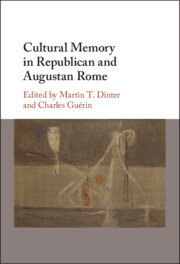Book contents
- Cultural Memory in Republican and Augustan Rome
- Cultural Memory in Republican and Augustan Rome
- Copyright page
- Contents
- Figures
- Contributors
- Acknowledgements
- Chapter 1 Introduction: What is Cultural Memory?
- Part I Writing Cultural Memory
- Part II Politicising Cultural Memory
- Part III Building Cultural Memory
- Part IV Locating Cultural Memory
- Chapter 19 Exchanging Memories: Coins, Conquest, and Resistance in Roman Iberia
- Chapter 20 Cicero and Clodius Together: The Porta Romana Inscriptions of Roman Ostia As Cultural Memory
- Chapter 21 Augustan Cultural Memories in Roman Athens
- Chapter 22 Different Pasts: Using and Constructing Memory in Augustan Carthage and Corinth
- Bibliography
- Index Locorum
- Index
Chapter 21 - Augustan Cultural Memories in Roman Athens
from Part IV - Locating Cultural Memory
Published online by Cambridge University Press: 27 April 2023
- Cultural Memory in Republican and Augustan Rome
- Cultural Memory in Republican and Augustan Rome
- Copyright page
- Contents
- Figures
- Contributors
- Acknowledgements
- Chapter 1 Introduction: What is Cultural Memory?
- Part I Writing Cultural Memory
- Part II Politicising Cultural Memory
- Part III Building Cultural Memory
- Part IV Locating Cultural Memory
- Chapter 19 Exchanging Memories: Coins, Conquest, and Resistance in Roman Iberia
- Chapter 20 Cicero and Clodius Together: The Porta Romana Inscriptions of Roman Ostia As Cultural Memory
- Chapter 21 Augustan Cultural Memories in Roman Athens
- Chapter 22 Different Pasts: Using and Constructing Memory in Augustan Carthage and Corinth
- Bibliography
- Index Locorum
- Index
Summary
In the early first century AD, the democratic institutions of Athens dedicated an honorary statue to the Roman senator Lucius Cassius Longinus.1 In the process, they re-used a monument consisting of a bronze statue and a marble base from the Classical period.2 Elsewhere, I have investigated why Athenians rededicated such old statues to Roman senators in this period. I have shown that old statues, that is statues from the Classical (and Hellenistic) period, were particularly suitable honours for Roman benefactors because of their shape and the cultural memory attached to them. I have detailed the manner in which they were employed as a political strategy both to engage powerful Romans and to manoeuvre them into a position of patronage and support for the city.
Keywords
- Type
- Chapter
- Information
- Cultural Memory in Republican and Augustan Rome , pp. 375 - 393Publisher: Cambridge University PressPrint publication year: 2023

